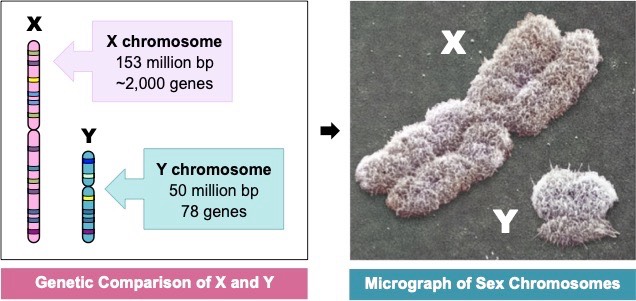Key Knowledge:
|
DNA is packaged and organised into structures called chromosomes, although there are differences between prokaryotes and eukaryotes
- Prokaryotes have a single circular chromosome (called the genophore) that is unpackaged (they may have additional plasmids)
- Eukaryotes have multiple linear chromosomes that are bound to histone proteins to form a condensed structure called chromatin
Homologous Chromosomes
Organisms that reproduce asexually will have only one copy of every chromosome – their cells are described as being haploid (n)
- Offspring will receive their entire chromosome set from the parental organism and hence will be genetically identical (i.e. a clone)
Offspring produced via sexual reproduction inherit their genetic sequences from both parents – their cells are subsequently diploid (2n)
- This means that these organisms will possess two copies of each chromosome (one of maternal origin ; one of paternal origin)
- These maternal and paternal chromosome pairs are called homologous chromosomes
Homologous chromosomes are chromosomes that share:
- The same structural features (e.g. same size, same banding patterns, same centromere positions)
- The same genes at the same loci positions (while the genes are the same, alleles may be different)
Homologous chromosomes must be separated into haploid gametes (via meiosis) prior to reproduction
- This prevents the chromosome number from continually doubling with each generation

Sex Chromosomes
Any chromosome that exists as part of a homologous pair in a sexually reproducing organism is called an autosome
- Humans have 22 pairs of autosomes out of 23 pairs in total (the final pair being the sex chromosomes)
Sex chromosomes are not considered to be homologous because they may not necessarily be paired within the organism
- While human females possess two X chromosomes (technically homologous), human males possess an X and Y chromosome
- Because sex chromosomes may be different, they are classified as being heterosomes (‘hetero’ = different / other)
The sex chromosomes (X and Y) can be distinguished based on size – the X chromosome is much larger and possesses more genes

Chromosome Number
Chromosome number is a characteristic feature of members of a particular species
- Organisms with different diploid numbers are unlikely to be able to interbreed (cannot form homologous pairs in zygotes)
- In cases where different species do interbreed, offspring are usually infertile (cannot form functional gametes)
- For instance, a horse (diploid = 64) and a donkey (diploid = 62) may produce an infertile mule (non-diploid = 63)

While different species may have different numbers of chromosomes, the chromosome number does not indicate genetic complexity
- A chicken has 78 chromosomes and roughly 17,000 genes, while a tomato has only 24 chromosomes but roughly 32,000 genes
Karyotyping
Karyotyping is the process by which chromosomes are organised and visualised for inspection
- Karyotyping is typically used to determine the gender of an unborn child and test for chromosomal abnormalities
Cells are harvested from the foetus before being chemically induced to undertake cell division (so chromosomes are visible)
- The stage during which mitosis is arrested will determine whether chromosomes appear with sister chromatids
Finally, chromosomes are stained and photographed, before being organised according to structure
- The visual profile generated is called a karyogram

Feature:
Unorganised
Organised by Size
Autosomes vs Heterosomes
Chromosome Types